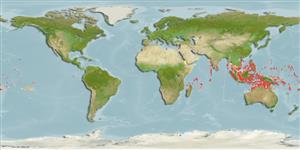Common names from other countries
>
Anguilliformes (Eels and morays) >
Muraenidae (Moray eels) > Muraeninae
Etymology: Gymnothorax: Greek, gymnos = naked + Greek, thorax, -akos = breast (Ref. 45335).
More on author: Seale.
Environment: milieu / climate zone / depth range / distribution range
Ecologia
marino associati a barriera corallina; distribuzione batimetrica 1 - 40 m (Ref. 30874), usually 20 - 40 m (Ref. 9710). Tropical; 19°N - 18°S
Indo-Pacific: East Africa to the Marquesan and Society islands, north to the Philippines.
Size / Peso / Age
Maturity: Lm ? range ? - ? cm
Max length : 50.0 cm TL maschio/sesso non determinato; (Ref. 48635); common length : 30.0 cm TL maschio/sesso non determinato; (Ref. 30404)
Spine dorsali (totale) : 0; Raggi dorsali molli (totale) : 0; Spine anali: 0; Raggi anali molli: 0; Vertebre: 122 - 130. Color brown with about 4 longitudinal rows of dendritic black blotches; very fine white scribbling anteriorly on body and fins; behind eye an irregular black spot bordered above and below by white; pores on side of jaws in large white spots. Juveniles distinctly marked on the head and adults plain brown, but showing black barring posteriorly on the dorsal and anal fins on the tail (Ref. 48635).
Occurs in ledges and rubble areas of outer reef slopes to depths of at least 40 m. Feeds on small fishes and crustaceans (Ref. 89972). Usually in caves below 20 m (Ref. 9710, 58302). Secretive in reefs during the day, usually only seen at night (Ref. 48635). Benthic (Ref. 58302). Minimum depth reported taken from Ref. 86942.
Life cycle and mating behavior
Maturities | Riproduzione | Spawnings | Egg(s) | Fecundities | Larve
Chen, H.-M., K.-T. Shao and C.T. Chen, 1994. A review of the muraenid eels (Family Muraenidae) from Taiwan with descriptions of twelve new records. Zool. Stud. 33(1):44-64. (Ref. 6934)
IUCN Red List Status (Ref. 130435)
CITES (Ref. 128078)
Not Evaluated
Threat to humans
Harmless
Human uses
Pesca: scarso interesse commerciale
Strumenti
Special reports
Download XML
Fonti Internet
Estimates based on models
Preferred temperature (Ref.
115969): 26.1 - 28.9, mean 28 (based on 294 cells).
Phylogenetic diversity index (Ref.
82804): PD
50 = 0.5000 [Uniqueness, from 0.5 = low to 2.0 = high].
Bayesian length-weight: a=0.00056 (0.00037 - 0.00084), b=3.21 (3.09 - 3.33), in cm Total Length, based on LWR estimates for this species & Genus-body shape (Ref.
93245).
Trophic level (Ref.
69278): 3.9 ±0.6 se; based on size and trophs of closest relatives
Resilienza (Ref.
120179): Medio, tempo minimo di raddoppiamento della popolazione 1.4 - 4.4 anni (Preliminary K or Fecundity.).
Fishing Vulnerability (Ref.
59153): Moderate vulnerability (40 of 100).
